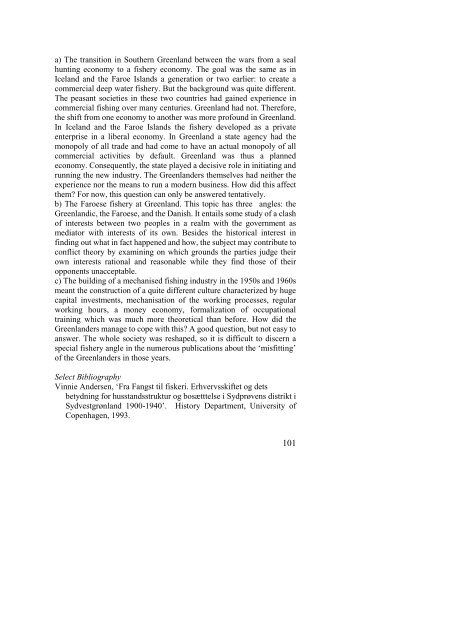The North Atlantic Fisheries, 1100-1976 - University of Hull
The North Atlantic Fisheries, 1100-1976 - University of Hull
The North Atlantic Fisheries, 1100-1976 - University of Hull
You also want an ePaper? Increase the reach of your titles
YUMPU automatically turns print PDFs into web optimized ePapers that Google loves.
a) <strong>The</strong> transition in Southern Greenland between the wars from a seal<br />
hunting economy to a fishery economy. <strong>The</strong> goal was the same as in<br />
Iceland and the Faroe Islands a generation or two earlier: to create a<br />
commercial deep water fishery. But the background was quite different.<br />
<strong>The</strong> peasant societies in these two countries had gained experience in<br />
commercial fishing over many centuries. Greenland had not. <strong>The</strong>refore,<br />
the shift from one economy to another was more pr<strong>of</strong>ound in Greenland.<br />
In Iceland and the Faroe Islands the fishery developed as a private<br />
enterprise in a liberal economy. In Greenland a state agency had the<br />
monopoly <strong>of</strong> all trade and had come to have an actual monopoly <strong>of</strong> all<br />
commercial activities by default. Greenland was thus a planned<br />
economy. Consequently, the state played a decisive role in initiating and<br />
running the new industry. <strong>The</strong> Greenlanders themselves had neither the<br />
experience nor the means to run a modern business. How did this affect<br />
them? For now, this question can only be answered tentatively.<br />
b) <strong>The</strong> Faroese fishery at Greenland. This topic has three angles: the<br />
Greenlandic, the Faroese, and the Danish. It entails some study <strong>of</strong> a clash<br />
<strong>of</strong> interests between two peoples in a realm with the government as<br />
mediator with interests <strong>of</strong> its own. Besides the historical interest in<br />
finding out what in fact happened and how, the subject may contribute to<br />
conflict theory by examining on which grounds the parties judge their<br />
own interests rational and reasonable while they find those <strong>of</strong> their<br />
opponents unacceptable.<br />
c) <strong>The</strong> building <strong>of</strong> a mechanised fishing industry in the 1950s and 1960s<br />
meant the construction <strong>of</strong> a quite different culture characterized by huge<br />
capital investments, mechanisation <strong>of</strong> the working processes, regular<br />
working hours, a money economy, formalization <strong>of</strong> occupational<br />
training which was much more theoretical than before. How did the<br />
Greenlanders manage to cope with this? A good question, but not easy to<br />
answer. <strong>The</strong> whole society was reshaped, so it is difficult to discern a<br />
special fishery angle in the numerous publications about the ‘misfitting’<br />
<strong>of</strong> the Greenlanders in those years.<br />
Select Bibliography<br />
Vinnie Andersen, ‘Fra Fangst til fiskeri. Erhvervsskiftet og dets<br />
betydning for husstandsstruktur og bosætttelse i Sydprøvens distrikt i<br />
Sydvestgrønland 1900-1940’. History Department, <strong>University</strong> <strong>of</strong><br />
Copenhagen, 1993.<br />
101















